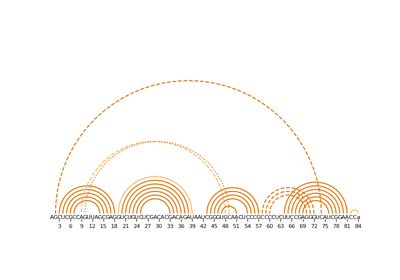biotite.structure.map_nucleotide¶
- biotite.structure.map_nucleotide(residue, min_atoms_per_base=3, rmsd_cutoff=0.28)[source]¶
Map a nucleotide to one of the 5 common bases Adenine, Guanine, Thymine, Cytosine, and Uracil. If one of those bases bound to Deoxyribose and Ribose is detected as input, the corresponding one- letter-code (
A,G,T,C,U) is returned.If a different nucleotide is given, it is mapped to the best fitting base using the algorithm described below.
The number of matching atom names with the reference bases is counted. If the number of matching atoms with all reference bases is less than the specified min_atoms_per_base (default 3) the nucleotide cannot be mapped and
Noneis returned.The bases with maximum number of matching atoms are selected and superimposed with each reference. The base with lowest RMSD is chosen. If the RMSD is more than the specified rmsd_cutoff (default 0.28) the nucleotide cannot be mapped and
Noneis returned.
- Parameters
- residueAtomArray
The nucleotide to be mapped.
- min_atoms_per_baseint, optional (default: 3)
The number of atoms the residue must have in common with the reference.
- rmsd_cutofffloat, optional (default: 0.28)
The maximum RSMD that is allowed for a mapping to occur.
- Returns
- one_letter_codestr
The one-letter-code of the mapped base.
Noneif no base can be mapped.- exact_matchbool
Wether or not the residue name exactly matches one of the common bases, i.e. the
res_nameof the input residue is one ofA,G,T,C,U,DA,DG,DT,DCorDU.
Notes
The default RMSD cutoff was chosen according to 1, where the same cutoff is used to detect if a given base is a nucleotide, by superimposing the base ring atoms onto a reference structure.
References
- 1
X. Lu, H. J. Bussemaker, W. K. Olson, “DSSR: an integrated software tool for dissecting the spatial structure of RNA,” Nucleic Acids Research, vol. 43, pp. e142-e142, December 2015. doi: 10.1093/nar/gkv716



